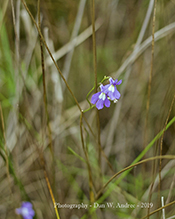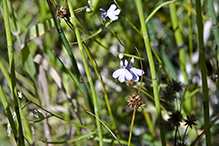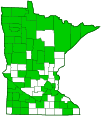Kalm’s lobelia
(Lobelia kalmii)
Conservation • Wetland • Description • Habitat • Ecology • Use • Distribution • Taxonomy
Description |
||
Kalm’s lobelia is a 4″ to 16″ tall, erect, perennial forb that rises on a single stem from a taproot and fibrous roots. The stems are erect, slender, hairless, and sometimes branched. Basal leaves are alternate, often deciduous, spatula-shaped, ⅜″ to 1 3 ⁄16″ long, ⅛″ to ¼″ wide, and sometimes under water. They are narrowed at the base to a short leaf stalk. The upper and lower surfaces are hairless. There are 4 to 15 stem leaves. Lower stem leaves are alternate and similar to basal leaves. Middle and upper stem leaves are stalkless and linear. They are held erect. The margins are untoothed, except on very robust plants. The inflorescence is a loose, elongated, unbranched cluster (raceme) at the end of the stem and branches. The flowers are on ascending, ⅛″ to ½″ long stalks (pedicels). The stalks have a single leaf-like, linear, up to ⅝″ long bract at the base and a pair of minute, awl-shaped, secondary bracts (bracteoles) at or above the middle. The pedicels are not as long as the subtending bracts. Each flower is ¼″ to ½″ long. At the base there are 5 green sepals (calyx) that are fused at their base into a top-shaped tube, then separated into 5 narrowly lance-shaped lobes. The calyx lobes are longer than the calyx tube. There are 5 mostly blue petals fused at their base into a corolla tube, then separated into an upper and lower lip with spreading lobes. The lower lip is large, 3-lobed, and mostly blue with white or white and yellow forming an “eye” near the center. The upper lip is much smaller, blue, and split nearly to the base into 2 spreading lobes. There are 5 stamens. The filaments are fused from just above the base into a tube surrounding the style. The anthers are fused into a ring around the style. The lower 2 anthers are shorter than the others and are bearded at the tip. The style and filament tube protrudes from between the 2 lobes of the upper lip and bends downward near the tip. The flowers are not fragrant. The fruit is a capsule. |
||
Height |
||
4″ to 16″ |
||
Flower Color |
||
Blue to white |
||
Similar Species |
||
Water lobelia (Lobelia dortmanna) is an unbranched aquatic plant requiring standing water. Basal leaves are hollow, fleshy tubes. Stem leaves are minute. It is found only in the northeast corner of the state. |
||
Habitat |
||
Wet. Calcareous swamps, fens, bogs, shores, meadows, and ditches. Full sun. |
||
Ecology |
||
Flowering |
||
July to September |
||
Pests and Diseases |
||
|
||
Use |
||
|
||
Distribution |
||||
|
Sources |
|||
| 5/3/2023 | ||||
Nativity |
||||
Native |
||||
Occurrence |
||||
|
||||
Taxonomy |
|||
| Kingdom | Plantae (Plants) | ||
| Division | Tracheophyta (Vascular Plants) | ||
| Subdivision | Spermatophytina (Seed Plants) | ||
| Class | Magnoliopsida (Dicots) | ||
Order |
Asterales (Sunflowers, Bellflowers, Fanflowers, and Allies) | ||
Family |
Campanulaceae (bellflower) | ||
| Subfamily | Lobelioideae (lobelia) | ||
Genus |
Lobelia (lobelias) | ||
| Section | Lobelia (typical lobelias) | ||
Subordinate Taxa |
|||
|
|||
Synonyms |
|||
Lobelia kalmii var. strictiflora Lobelia strictiflora |
|||
Common Names |
|||
brook lobelia Kalm’s lobelia Ontario lobelia |
|||
Glossary
Bract
Modified leaf at the base of a flower stalk, flower cluster, or inflorescence.
Bracteole
A small, often secondary bract within an inflorescence; a bract that is borne on a petiole instead of subtending it; bractlet.
Calcareous
Alkaline; rich in limestone; containing a high proportion of calcium carbonate.
Calyx
The group of outer floral leaves (sepals) below the petals, occasionally forming a tube.
Corolla
A collective name for all of the petals of a flower.
Raceme
An unbranched, elongated inflorescence with stalked flowers. The flowers mature from the bottom up.
Sepal
An outer floral leaf, usually green but sometimes colored, at the base of a flower.
Visitor Photos |
|||||
Share your photo of this plant. |
|||||
| This button not working for you? Simply email us at info@MinnesotaSeasons.com. Attach one or more photos and, if you like, a caption. |
|||||
Dan W. Andree |
|||||
I think this is a Kalm's Lobelia... very small blossoms. They were growing in kind of a damp area on a Wildlife Management Area in Norman co. Mn. 9-7-19. |
 |
||||
MinnesotaSeasons.com Photos |
|||||
 |
|||||

Slideshows |
||

Visitor Videos |
|||
Share your video of this plant. |
|||
| This button not working for you? Simply email us at info@MinnesotaSeasons.com. Attach a video, a YouTube link, or a cloud storage link. |
|||
Other Videos |
|||

Visitor Sightings |
|||||
Report a sighting of this plant. |
|||||
| This button not working for you? Simply email us at info@MinnesotaSeasons.com. Be sure to include a location. |
|||||
| Dan W. Andree 9/7/2019 |
Location: a Wildlife Management Area in Norman Co. MN I think this is a Kalm's Lobelia...very small blossoms. They were growing in kind of a damp area on a Wildlife Management Area in Norman co. Mn. 9-7-19. |
 |
|||
MinnesotaSeasons.com Sightings |
|||||

|
Created: Last Updated: © MinnesotaSeasons.com. All rights reserved. |
